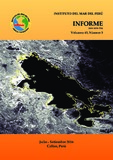Por favor, use este identificador para citar o enlazar este ítem:
https://hdl.handle.net/20.500.12958/3111Registro completo de metadatos
| Campo DC | Valor | Lengua/Idioma |
|---|---|---|
| dc.contributor.author | Paulino Rojas, Carlos | |
| dc.contributor.author | Xu, Han | |
| dc.contributor.author | Alburqueque, Edward | |
| dc.contributor.author | Velaochaga, Germán | |
| dc.date.accessioned | 2017-02-03T19:55:12Z | |
| dc.date.available | 2017-02-03T19:55:12Z | |
| dc.date.issued | 2016 | |
| dc.identifier.citation | Inf Inst Mar Perú 43(3), 2016. p. 242-251 | es_ES |
| dc.identifier.uri | https://hdl.handle.net/20.500.12958/3111 | |
| dc.description | Informe IMARPE 43(3), 2016 p. 242-251 | es_ES |
| dc.description.abstract | Imágenes satelitales del sensor MERSI de 250 m de resolución espacial fueron usadas para la estimación de la concentración de clorofila-a del Lago Titicaca y su relación con los productos calibrados de concentración de clorofila-a del MODIS (AQUA) y VIIRS (NPP), los cuales son recepcionados y procesados por el sistema TERASCAN del IMARPE. Para la estimación de concentración de clorofila-a se usó 3 modelos de razón de bandas (MOD2-1, MOD2-2 y MOD2- 3) a partir de valores de reflectancia de las imágenes MERSI. El análisis de distribución de clorofila-a en los perfiles P1 y P2 indicó que el modelo MOD2-2 es el que se aproxima más a los valores calculados por VIIRS y MODIS. Los resultados evidenciaron una correlación de R=0,846 entre los valores de clorofila-a del MOD2-2 y VIIRS en el perfil P1, una correlación menor en el perfil P2 de R=0,472 y una óptima correlación para valores de clorofila-a en un rango entre 0 a 2 mg/m3 de R=0945. Se evidenció la importancia de la resolución espacial de 250 m del modelo MOD2-2 en la estimación de la clorofila en el Lago Titicaca, porque permite identificar características que no pueden ser registradas con los sensores MODIS. Tanto para áreas abiertas como para zonas con abundante vegetación, los productos del MODIS y VIIRS de 1 km se saturan fácilmente, como en el caso de la bahía de Puno. | es_ES |
| dc.description.abstract | ABSTRACT: Satellite images of the sensor MERSI of 250 m of spatial resolution were used for the estimation of the concentration of chlorophyll-a of Lake Titicaca and its relationship with the calibrated products concentration of chlorophyll-a from MODIS (AQUA) and VIIRS (NPP), which are received and processed by the TERASCAN system of the IMARPE. For the estimation of concentration of chlorophyll-a, we used 3 models of reason of bands (MOD2-1, MOD2-2 and MOD2-3) from reflectance values of the images MERSI. The analysis of distribution of chlorophyll-a in the profiles P1 and P2 indicated that the model MOD2-2 is the one that is closest to the calculated values by VIIRS and MODIS. The results showed a correlation of R=0.846 between the values of chlorophyll-a MOD2-2 and VIIRS in profile P1, a correlation lower in the profile P2 of R=0,472 and an optimal correlation for values of chlorophyll-a in a range between 0 to 2 mg/m3 of R=0945. It was proved the importance of the spatial resolution of 250 m the model MOD2-2 in the estimation of chlorophyll in the Lake Titicaca, because it allows you to identify features that may not be registered with the MODIS sensors. Both for open areas such as for areas with abundant vegetation, in which products from MODIS and VIIRS of 1 km are saturated easily, as in the case of the Bay of Puno. | |
| dc.language.iso | spa | es_ES |
| dc.publisher | Callao | es_ES |
| dc.relation.ispartofseries | Informe IMARPE;Vol. 43, N° 3, 2016 | |
| dc.rights | info:eu-repo/semantics/openAccess | es_ES |
| dc.rights.uri | https://creativecommons.org/licenses/by/4.0/ | |
| dc.source | Instituto del Mar del Perú - IMARPE | es_ES |
| dc.source.uri | Repositorio Digital IMARPE | es_ES |
| dc.subject | Clorofila | es_ES |
| dc.subject | Lago Titicaca | es_ES |
| dc.subject | Imágenes Satelitales | es_ES |
| dc.subject | Puno | es_ES |
| dc.title | Estimación de concentración de clorofila-a en el lago Titicaca usando imágenes satelitales MERSI | es_ES |
| dc.title.alternative | Estimated chlorophyll-a in Titicaca lake using MERSI satellite images | es_ES |
| dc.type | info:eu-repo/semantics/article | es_ES |
| Aparece en las colecciones: | Informe vol. 43(3), 2016 | |
Ficheros en este ítem:
| Fichero | Descripción | Tamaño | Formato | |
|---|---|---|---|---|
| Informe 43(3)-1.pdf | 5,21 MB | Adobe PDF |  Visualizar/Abrir |
Este ítem está sujeto a una licencia Creative Commons Licencia Creative Commons

